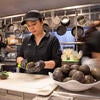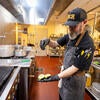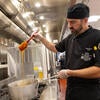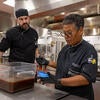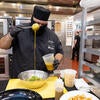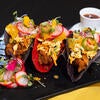University of California, Riverside
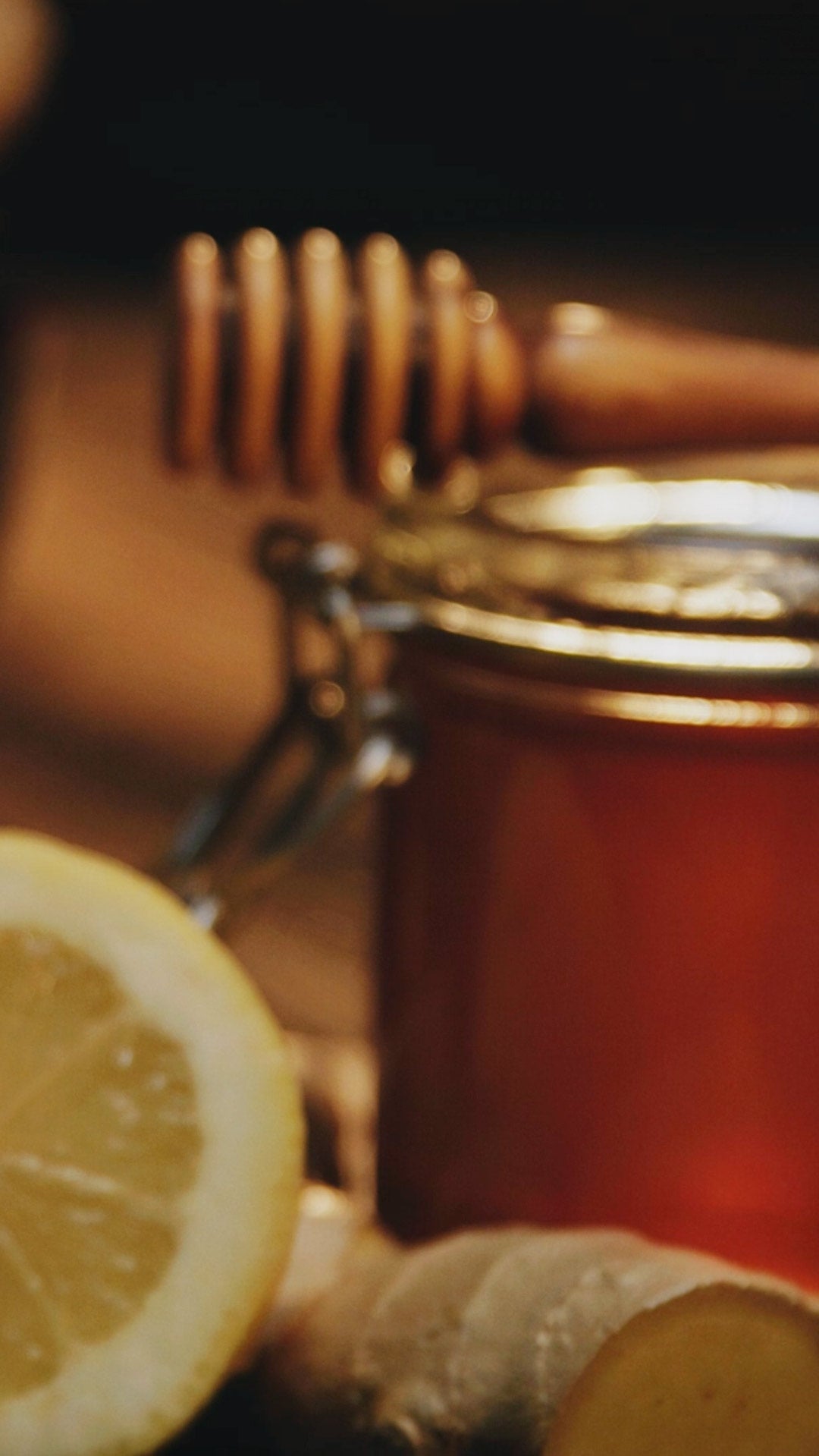
Lab to Table
A partnership between campus chefs and researchers is serving up UCR-inspired dishes and connecting the community through food
W alking around campus, one could easily make a meal of the fruits of UCR researchers’ labors. Diners can order grilled avocado and wash it down with a citrus beer on tap at the Barn. Emerbee’s cafe offers a selection of honey-infused coffee drinks. At the Glasgow Residential Restaurant, honey and citrus are key ingredients in salads, sauces, dressings, and more. These menu items reflect the many collaborations between researchers and UCR Dining Services to create unique dishes and beverages based on the university’s agricultural research.
UCR has attracted national attention as home to the largest and most diverse collection of citrus in the United States, a world-renowned center leading efforts to safeguard honey bees, and a 70-year-old avocado breeding program. Using products developed through these endeavors allows chefs to not only create tasty dishes but link the work of the university’s researchers with the food they serve.
Dickerson shares a behind-the-scenes look at dining on the UCR campus.
“Our team gets very excited when they can connect the story and the history of the dishes they’re going to create back to UCR,” said Lanette Dickerson, UCR executive chef and director of culinary operations. “Obviously, UCR’s history goes back to the Citrus Experiment Station, so we have, from the very start, that connection to agriculture and food.”
Despite a heritage dating back to the station’s founding in 1907 — long before the campus itself opened in 1954 — it’s only in the past decade that Dining Services has expanded its UCR-produced offerings beyond freshly squeezed orange juice served at student dining halls. Campus chefs now use citrus, honey, and avocado products developed or grown by researchers in varied and sophisticated ways, from ceviche to salads to s’mores. And they continue to explore new avenues, with plans underway for a campus ice cream shop opening this fall that will feature flavors from fruit picked at the Givaudan Citrus Variety Collection.
“There’s so many ways you can use citrus in different types of food and flavors and sauces, so it’s kind of incorporated into every aspect of cooking,” said Alexander Meister, associate director of catering and hospitality for Dining Services.
The food and dining staff say it’s hard to beat the quality of ingredients coming straight from the nearby citrus groves and beehives on campus, as well as an avocado orchard at a UC Agricultural and Natural Resources field station in Irvine.
“You’re using fresh UCR citrus,” Dickerson said. “That’s the best part of it. It just makes everything better.”
“UCR’s history goes back to the Citrus Experiment Station, so we have, from the very start, that connection to agriculture and food.”
— Lanette Dickerson
Growing a Partnership
The current partnership between UCR researchers and Dining Services began a decade ago with the launch of the Citrus Gifts line, featuring marmalades, balsamic vinegar, and olive oils using UCR-developed food products and sold at campus dining venues. Over the years, it expanded to include items such as citrus chocolate bars, jarred honey, and even body care products such as a honey lip balm and a honey and lemon lager soap bar.
Tracy Kahn, curator of the Citrus Variety Collection, said the idea sprang from discussions about utilizing the extra fruit grown at the 25-acre grove. The gift line, now also sold online, soon became popular with students, employees, and alumni as keepsakes only available through UCR.
“It’s certainly one thing to get the word out about the research that we do and the resources available at UCR,” Kahn said. “But people get really excited to be able to connect with something that was developed on campus, or is part of our campus, through a product they can take home or share with others.”
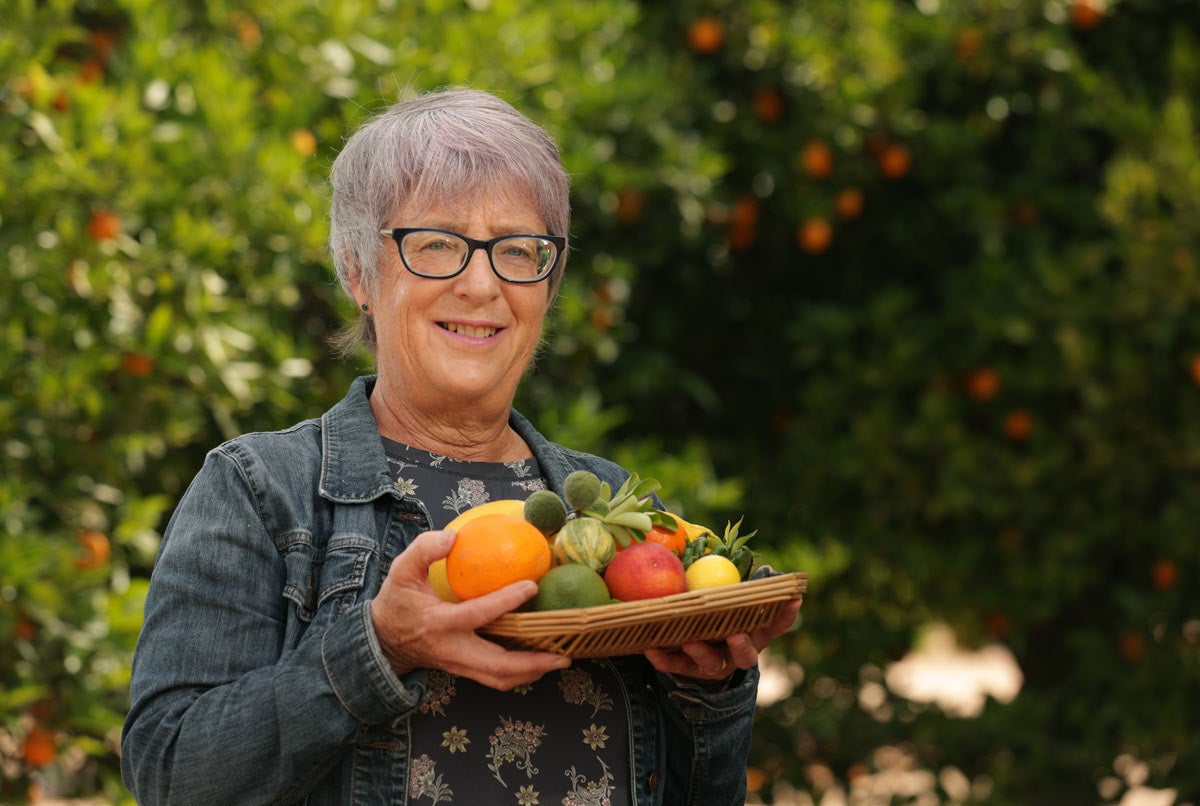
Kahn is curator of the Givaudan Citrus Variety Collection at UCR. (UCR/Stan Lim)
Most of the gift products are manufactured by outside vendors, but as the line grew, UCR chefs began incorporating items like the marmalades into their cooking and using citrus in more ways, creating marinades, vinaigrettes, and sauces, among other uses.
At special events, like the recent UCR Gala celebration, catering is often asked to create menus highlighting ingredients resulting from UCR research. One of the most popular items ordered for catered events is a roasted chicken made with a reduction of citrus and honey.
“Our job is to help tell the story of UCR for events,” Meister said.
The reopening of the Barn in 2020, after a major renovation and expansion, provided another opportunity to use UCR citrus in a new way. Dining Services contracted with Ironfire Brewing in Temecula to create signature beers with fruit picked at the Citrus Variety Collection.
Each brew is different as the flavors rotate based on season and what’s fresh, said Dining Services general manager Moses Preciado. The Stable restaurant at the Barn, which is open to both the university community and the public, usually has three or four on tap. Recent flavors include lemon, blood orange, grapefruit, and mandarin.
“These are our bestselling beers,” Preciado said.
“People get really excited to be able to connect with something that was developed on campus.”
— Tracy Kahn
Buzzworthy Byproducts
For Barbara Baer-Imhoof and Boris Baer, founders of the Center for Integrative Bee Research (CIBER), honey is a byproduct of their work, which involves finding solutions for honey bee colony collapse. They provide Dining Services with 500 pounds of honey a year, delivered in buckets, and receive part of the proceeds from Citrus Gifts and Emerbee’s, an outdoor cafe that specifically spotlights honey ingredients and the work conducted at CIBER. Those funds are then used to further support CIBER’s research. The Baers, who are married, sometimes visit Emerbee’s to enjoy a coffee or dishes like a yogurt and honey muesli.
“I can taste our honey because it has a signature taste,” Barbara Baer-Imhoof said. “Each season, we know the taste and we recognize it. It makes me proud.”

The Baers head the Center for Integrative Bee Research (CIBER) at UCR. (UCR/Stan Lim)
It’s a convenient spot to take visitors, such as fellow bee researchers or industry representatives, since bees and CIBER are prominently displayed in the cafe’s design and informational posters — another point of pride for the Baers.
“There is no other campus in the world that I’m aware of that is running a bee-themed cafe,” Boris Baer said.
Earlier this year, a group of UCR chefs visited one of the CIBER apiaries where they donned beekeeper suits and joined the Baers to collect honey from the beehives. They learned how different batches of honey have different coloring and flavors, and the importance of bees in food production.
On a recent afternoon at the Glasgow Residential Restaurant, Mario Valencia, a culinary supervisor, prepared some honey sriracha tacos. It’s an example of how the visit to the apiary inspired him to use honey in different ways, he said.
“We really saw how the honey is made, where it comes from, the whole life cycle for the bees,” he said.
Across from him, Dickerson was stirring honey in a 20-gallon warming pot, part of the process of filtering to remove pollen and bee parts, reducing moisturization, and avoiding crystallization.
“The flavor of this is phenomenal,” she said. “It’s very floral. It doesn’t taste like any honey you get off the market.”
Campus chefs have used the versatile ingredient to create balsamic honey vinegar, honey jalapeño jam, and honey butter grilled cheese sandwiches. It’s been added to many desserts, including s’mores and caramel popcorn.
“The flavor of this is phenomenal. It’s very floral. It doesn’t taste like any honey you get off the market.”
— Lanette Dickerson
Luna in the Limelight
This past spring, Dining Services added several avocado-themed dishes to the Barn’s menu inspired by the response to the new Luna UCR™ avocado variety developed by UCR agricultural scientists. Preciado reached out last fall to UCR horticulturist Mary Lu Arpaia and Eric Focht, a staff research associate in the Botany and Plant Sciences Department. Due to high demand, there weren’t enough Luna avocados available, but chefs were able to use other varieties developed through UCR’s avocado breeding program such as the GEM avocado.
They created several dishes and had the researchers sample them before selecting three for the menu: a grilled avocado with imitation crab meat and crispy wontons, an avocado grain bowl, and a Mediterranean-inspired salad.
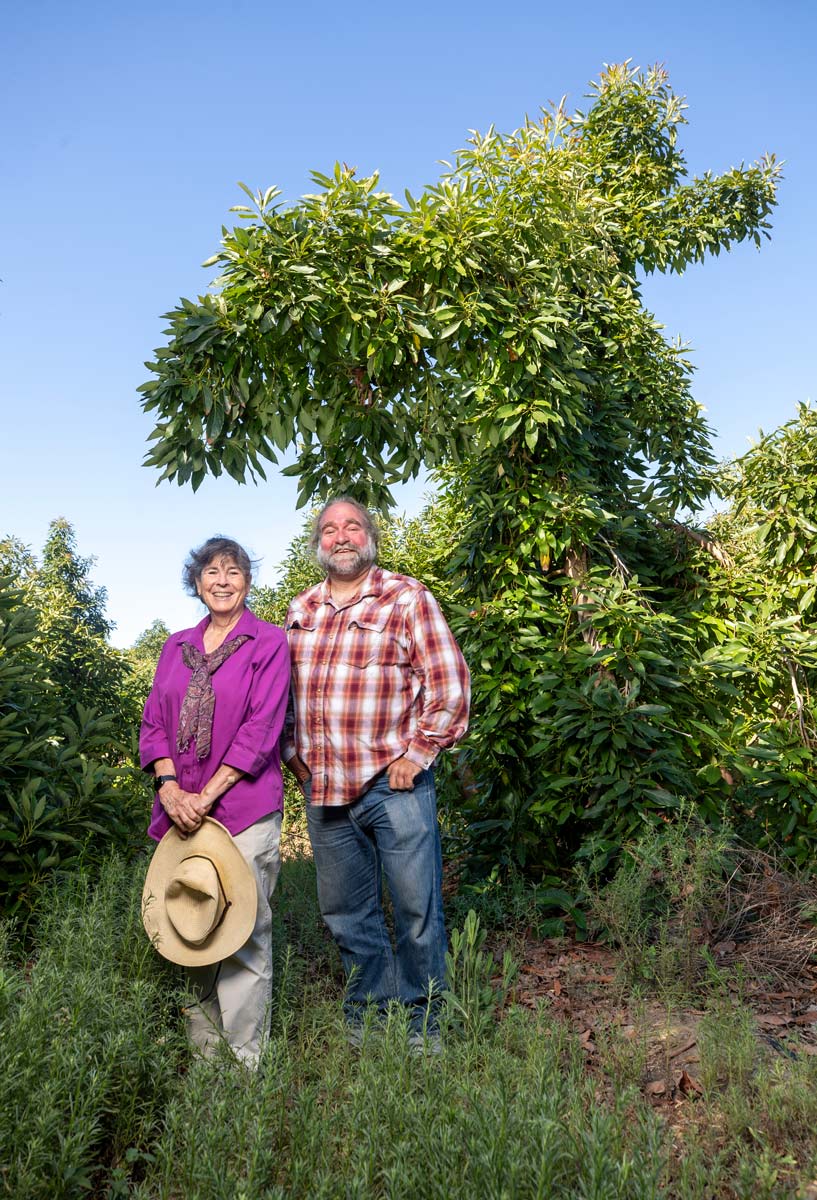
Researchers Arpaia (left) and Focht are credited as inventors of the Luna UCR™ variety. (UCR/Stan Lim)
“Let the avocado shine through as the star,” was the main directive for each dish, Preciado said, and both he and Focht hope to utilize the Luna variety in the future. Focht said he liked seeing avocado as a central part of a meal and not just a dip or side dish.
“Everybody thinks just guacamole or salads when they think avocado, so when I see Moses and his team taking a different twist on it, I appreciate that,” he said. “There are different ways you can use avocados.”
The new dishes were on the menu when UCR hosted a conference in April with Eurosemillas, the Spanish company marketing the Luna avocado to growers.
“That was a big success,” Focht said. “I think we made a good impression, and the Barn did too.”
“Everybody thinks just guacamole or salads when they think avocado, so when I see Moses and his team taking a different twist on it, I appreciate that.”
— Eric Focht
A Healthy Ecosystem
Beyond the access to fresh ingredients, a key aspect of the partnerships is the valuable insights researchers provide that most chefs would not get in a normal restaurant job, Dickerson said.
“The nice thing is they’re all very passionate about what they do, and they’re also foodies, so they’re very excited about our connections,” Dickerson said. “We try to include them in our ideas with what we’re doing with the product.”
Dining Services employees regularly visit the Citrus Variety Collection to pick fruit and get tasting tours from Kahn. She’ll let them know the best season to pick the different varieties, which fruit may be a bit tart, which are on the sweeter side, and what flavors may work with other ingredients. She’s encouraged the use of varieties developed at UCR like the Tango mandarin, Allspice mandarin, and Oroblanco grapefruit hybrid.
In trying out avocados, Focht showed them varieties that are softer and creamier, ones that are firm and meatier, flavors that range from light to nutty, and how those traits change with crops from different seasons. Just as they learn from the researchers, Dining Services sees the dishes they create as an opportunity to pass on that information to customers, whether it’s how UCR is researching ways to stave off citrus-destroying bacteria or creating avocado varieties that are easier to harvest.
The honey products offer a lesson on the mini ecosystem on campus, with bees gathering pollen from the citrus and avocado groves and other nearby plants to create a unique flavor that reflects the local flora. In turn, Dining Services provides the Baers with sugar and oil to feed the bees and ward off ants. The Baers say that ecosystem reflects their goal of safeguarding bees to preserve their vital role in food production. One way to do that is using local products like the honey harvested on campus, they said.
“When I get asked, ‘What can you do to save the bees?’ one of the answers I say is buy local honey,” Boris Baer said. “It will be more expensive, but if you support the local beekeeper, that beekeeper will look after those bees, and the honey will not be mass-produced and will have a unique taste.”
Use of local products helps create a dialogue with diners about where the food comes from, said Kurt Duffner, director of retail and restaurants for Dining Services. He recounted a recent conversation with a customer at the Barn who was pleased to see a clementine marmalade back in stock. The customer was astonished to learn not only was the clementine grown nearby, but it had been picked from the groves only a few weeks earlier.
“That’s one of the joys you get when you’re talking about the relationship we have and the products that we have access to,” Duffner said. “When you tell somebody where it came from, it’s just a great moment. We’re representing UCR in the community and connecting people to campus in a real way through food, which everybody can relate to.”

Highlander Cookbook
Spicy Crab-Stuffed Grilled Avocado
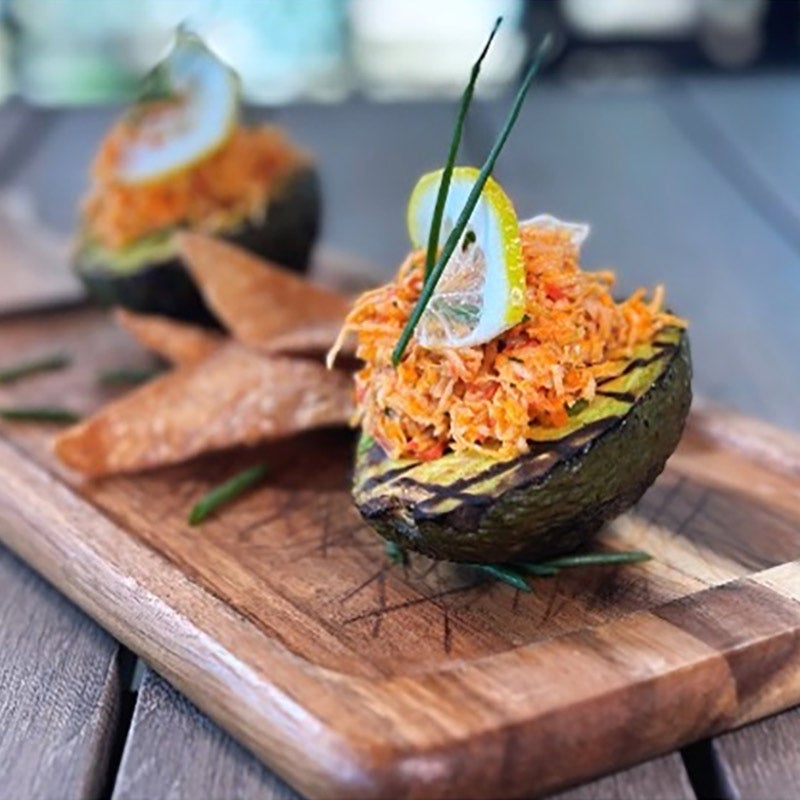
Ingredients:
- 4 avocadoes, halved & seeded
- 1 tablespoon olive oil
- 2 ounces mayonnaise
- 1 ounce crunchy garlic chili sauce
- 4 ounces shallot, minced
- 1 ounce carrot, fine shredded
- ½ teaspoon cilantro, chopped fine
- 10 ounces crab meat (or imitation crab)
- Salt and pepper to taste
- Optional: lemon slices, cut chives, fried wonton wrappers
Directions:
- Cut avocado in half and remove the seed. Rub flesh side with olive oil and season with salt and pepper.
- Place avocado on a preheated grill, flesh side down, for 30 seconds. Then turn 45 degrees and cook for another 30 seconds. Remove from grill and set aside.
- Combine mayonnaise, crunchy garlic chili sauce, shallot, carrot, cilantro, crab meat, and salt and pepper in a mixing bowl. Mix well with a rubber spatula. Adjust seasoning with salt and pepper to taste.
- Arrange grilled avocado halves flesh side up. Portion crab mixture on top of avocado. Garnish with lemon slices and cut chives. Serve with fried wonton wrappers.
